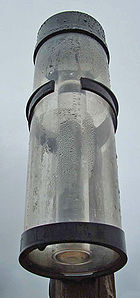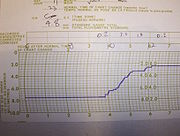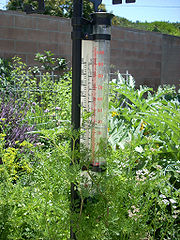
Rain gauge
Encyclopedia



Meteorology
Meteorology is the interdisciplinary scientific study of the atmosphere. Studies in the field stretch back millennia, though significant progress in meteorology did not occur until the 18th century. The 19th century saw breakthroughs occur after observing networks developed across several countries...
and hydrologists to gather and measure the amount of liquid precipitation
Precipitation (meteorology)
In meteorology, precipitation In meteorology, precipitation In meteorology, precipitation (also known as one of the classes of hydrometeors, which are atmospheric water phenomena is any product of the condensation of atmospheric water vapor that falls under gravity. The main forms of precipitation...
over a set period of time.
History
The first known records of rainfalls were kept by the Ancient GreeksAncient Greece
Ancient Greece is a civilization belonging to a period of Greek history that lasted from the Archaic period of the 8th to 6th centuries BC to the end of antiquity. Immediately following this period was the beginning of the Early Middle Ages and the Byzantine era. Included in Ancient Greece is the...
about 500 B.C. This was followed 100 years later by people in India
India
India , officially the Republic of India , is a country in South Asia. It is the seventh-largest country by geographical area, the second-most populous country with over 1.2 billion people, and the most populous democracy in the world...
using bowls to record the rainfall. The readings from these were correlated against expected growth, and used as a basis for land taxes. In the Arthashastra
Arthashastra
The Arthashastra is an ancient Indian treatise on statecraft, economic policy and military strategy which identifies its author by the names Kautilya and , who are traditionally identified with The Arthashastra (IAST: Arthaśāstra) is an ancient Indian treatise on statecraft, economic policy and...
, used for example in Magadha
Magadha
Magadha formed one of the sixteen Mahājanapadas or kingdoms in ancient India. The core of the kingdom was the area of Bihar south of the Ganga; its first capital was Rajagriha then Pataliputra...
, precise standards were set as to grain production. Each of the state storehouses were equipped with a standardised rain gauge to classify land for taxation purposes.
While some sources state that the much later cheugugi
Cheugugi
Cheugugiis the world first rain gauge which is invented and utilized by Joseon Dynasty of Korea...
of Korea
Korea
Korea ) is an East Asian geographic region that is currently divided into two separate sovereign states — North Korea and South Korea. Located on the Korean Peninsula, Korea is bordered by the People's Republic of China to the northwest, Russia to the northeast, and is separated from Japan to the...
was the world's first gauge, other sources say that Jang Yeong-sil
Jang Yeong-sil
Jang Yeong-sil was a prominent Korean scientist and astronomer during the Joseon Dynasty . Although Jang was...
developed or refined an existing gauge. In 1662, Christopher Wren
Christopher Wren
Sir Christopher Wren FRS is one of the most highly acclaimed English architects in history.He used to be accorded responsibility for rebuilding 51 churches in the City of London after the Great Fire in 1666, including his masterpiece, St. Paul's Cathedral, on Ludgate Hill, completed in 1710...
created the first tipping-bucket rain gauge in Britain
United Kingdom
The United Kingdom of Great Britain and Northern IrelandIn the United Kingdom and Dependencies, other languages have been officially recognised as legitimate autochthonous languages under the European Charter for Regional or Minority Languages...
.

Principles
Most rain gauges generally measure the precipitation in millimeters.The level of rainfall is sometimes reported as inchInch
An inch is the name of a unit of length in a number of different systems, including Imperial units, and United States customary units. There are 36 inches in a yard and 12 inches in a foot...
es or centimeters.
Rain gauge amounts are read either manually or by automatic weather station
Automatic weather station
An automatic weather station is an automated version of the traditional weather station, either to save human labour or to enable measurements from remote areas...
(AWS). The frequency of readings will depend on the requirements of the collection agency. Some countries will supplement the paid weather observer with a network of volunteers to obtain precipitation data (and other types of weather) for sparsely populated areas.
In most cases the precipitation is not retained, however some stations do submit rainfall (and snowfall) for testing, which is done to obtain levels of pollutants.
Rain gauges have their limitations. Attempting to collect rain data in a hurricane can be nearly impossible and unreliable (even if the equipment survives) due to wind extremes. Also, rain gauges only indicate rainfall in a localized area. For virtually any gauge, drops will stick to the sides or funnel of the collecting device, such that amounts are very slightly underestimated, and those of .01 inches or .25 mm may be recorded as a trace.
Another problem encountered is when the temperature is close to or below freezing. Rain may fall on the funnel and freeze or snow may collect in the gauge and not permit any subsequent rain to pass through.
Rain gauges should be placed in an open area where there are no obstructions, such as building or trees, to block the rain. This is also to prevent the water collected on the roofs of buildings or the leaves of trees from dripping into the rain gauge after a rain, resulting in inaccurate readings.
Types
Types of rain gauges include graduated cylinderGraduated cylinder
A graduated cylinder, measuring cylinder or graduate is a piece of laboratory equipment used to accurately measure the volume of a liquid. Water displacement can be used to find out the volume of a solid. Graduated cylinders are generally more accurate and precise for this purpose than flasks and...
s, weighing gauges, tipping bucket gauges, and simple buried pit collectors. Each type has its advantages and disadvantages for collecting rain data.
Standard rain gauge
The standard NOAANational Oceanic and Atmospheric Administration
The National Oceanic and Atmospheric Administration , pronounced , like "noah", is a scientific agency within the United States Department of Commerce focused on the conditions of the oceans and the atmosphere...
rain gauge, developed around the start of the 20th century, consists of a funnel attached to a graduated cylinder (2 cm in diameter) that fits inside a larger outside container (20 cm in diameter and 50 cm tall). If the water overflows the inside graduated cylinder, the outside larger container will catch it. When measurements are taken, the height of the water in the small graduated cylinder is measured and the excess overflow in the large container is carefully poured into another graduated cylinder and measured to give the total rainfall. In locations using the metric system, the cylinder is usually marked in mm and in the picture above will measure up to 250 millimetres (9.8 in) of rainfall. Each horizontal line on the cylinder is 5 centimetres (2 in) in areas using the metric system; in areas using Imperial units each horizontal line represents 0.01 inch. The larger container collects any rainfall amounts over 25 mm that flows from a small hole near the top of the cylinder. A metal pipe is attached to the container and can be adjusted to ensure the rain gauge is level. This pipe then fits over a metal rod that has been placed in the ground.
Weighing precipitation gauge
A weighing-type precipitation gauge consists of a storage bin, which is weighed to record the mass. Certain models measure the mass using a pen on a rotating drum, or by using a vibrating wire attached to a data loggerData logger
A data logger is an electronic device that records data over time or in relation to location either with a built in instrument or sensor or via external instruments and sensors. Increasingly, but not entirely, they are based on a digital processor...
. The advantages of this type of gauge over tipping buckets are that it does not underestimate intense rain, and it can measure other forms of precipitation, including rain, hail and snow. These gauges are, however, more expensive and require more maintenance than tipping bucket gauges.
The weighing-type recording gauge may also contain a device to measure the quantity of chemicals contained in the location's atmosphere. This is extremely helpful for scientists studying the effects of greenhouse gases released into the atmosphere and their effects on the levels of the acid rain. Some Automated Surface Observing System (ASOS) units use an automated weighing gauge called the AWPAG (All Weather Precipitation Accumulation Gauge).
Tipping bucket rain gauge

Seesaw
A seesaw is a long, narrow board pivoted in the middle so that, as one end goes up, the other goes down.-Mechanics:Mechanically a seesaw is a lever and fulcrum....
-like container. After a pre-set amount of precipitation falls, the lever tips, dumping the collected water and sending an electrical signal. An old-style recording device may consist of a pen mounted on an arm attached to a geared wheel that moves once with each signal sent from the collector. In this design, the wheel turns the pen arm moves either up or down leaving a trace on the graph and at the same time making a loud click. Each jump of the arm is sometimes referred to as a 'click' in reference to the noise. The chart is measured in 10 minute periods (vertical lines) and 0.4 mm (0.015 in) (horizontal lines) and rotates once every 24 hours and is powered by a clockwork motor that must be manually wound.

Modern tipping rain gauges consist of a plastic collector balanced over a pivot. When it tips, it actuates a switch (such as a reed switch
Reed switch
The reed switch is an electrical switch operated by an applied magnetic field. It was invented at Bell Telephone Laboratories in 1936 by W. B. Ellwood. It consists of a pair of contacts on ferrous metal reeds in a hermetically sealed glass envelope...
) which is then electronically recorded or transmitted to a remote collection station.
Tipping gauges can also incorporate weighing gauges. In these gauges, a strain gauge is fixed to the collection bucket so that the exact rainfall can be read at any moment. Each time the collector tips, the strain gauge (weight sensor) is re-zeroed to null out any drift.
To measure the water equivalent of frozen precipitation, a tipping bucket may be heated to melt any ice and snow that is caught in its funnel. Without a heating mechanism, the funnel often becomes clogged during a frozen precipitation event, and thus no precipitation can be measured . Many Automated Surface Observing System (ASOS) units use heated tipping buckets to measure precipitation
Optical rain gauge
These have a row of collection funnels. In an enclosed space below each is a laser diodeLaser diode
The laser diode is a laser where the active medium is a semiconductor similar to that found in a light-emitting diode. The most common type of laser diode is formed from a p-n junction and powered by injected electric current...
and a photo transistor detector. When enough water is collected to make a single drop, it drips from the bottom, falling into the laser beam path. The sensor is set at right angles to the laser so that enough light is scattered to be detected as a sudden flash of light. The flashes from these photo detectors are then read and transmitted or recorded.
Acoustic rain gauge
The acoustic disdrometer developed by Stijn de Jong is an acoustic rain gauge. The big advantage of this design is that it is a lot less costly.See also
- Automated airport weather stationAutomated airport weather stationAutomated airport weather stations are automated sensor suites which are designed to serve aviation and meteorological observing needs for safe and efficient aviation operations and weather forecasting...
- Snow gaugeSnow gaugeA snow gauge is a type of instrument used by meteorologists and hydrologists to gather and measure the amount of solid precipitation over a set period of time....
- SnowboardSnowboard (meteorology)A snowboard is a meteorological tool used to aid in the obtaining of accurate measurement of snow accumulation.-Specifications:Snowboards are typically flat pieces of plywood painted a light color , around in length and width and around thick.-Reasons for use:Measuring snow in grass the grass...
- disdrometerDisdrometerA disdrometer is an instrument used to measure the drop size distribution and velocity of falling hydrometeors. Some disdrometers can distinguish between rain, graupel, and hail....
- millimeter

